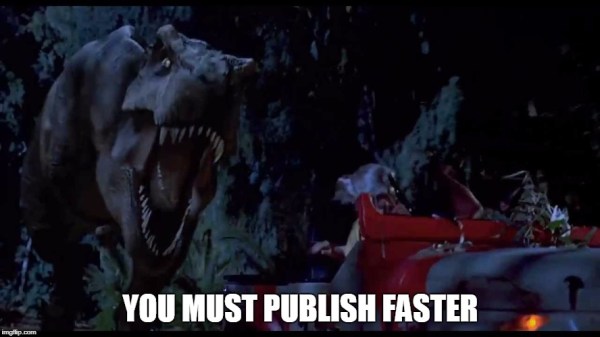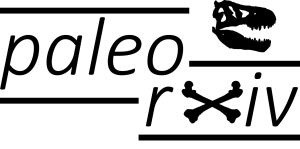Welcome to paleorXiv!
This week, I am very excited to announce the launch of paleorXiv! On the first day, we published 16 manuscripts alone, which is a great success by any measure!
What does this mean?
PaleorXiv provides a non-profit platform for paleontologists to freely upload their working papers, pre-prints, accepted manuscripts (post-prints), and published papers. We also provide options to link data and code, and for article versioning, thanks to the technical capabilities of the Open Science Framework. PaleorXiv is dedicated to speeding and opening up paleontological research and helping to build the future of scholarly communication.
Important features
- It’s free for all authors.
- It’s ‘Open Access’. This means all content is freely available under a CC BY 4.0 license, which maximises re-use potential while protecting authors.
- Increase your impact. Research has shown that preprints receive more citations earlier and faster than papers not accompanied by preprints.
- Preprints are all indexed by Google Scholar.
- Preprints all receive DOIs, making them fully citable.
- You can assign final version publication DOIs to your articles on paleorXiv.
- Version control. Update your articles to the latest versions as your research goes through peer review. Users are automatically directed to the latest versions.
- Sustainability. The Open Science Framework is well-funded to make sure that your work is stably hosted, and secure for the future. Storage on paleorXiv beats a desktop hard-drive any day.
- Have your cake and eat it. Submitting to paleorXiv enables you to have Open Access for free, while also submitting to any journal of your choice.
- We are supported and maintained by the international Paleontology community. This means you don’t need to give your work to for-profit platforms like ResearchGate and Academia.edu anymore, risking a potential legal backlash.
- Submission takes around 5 minutes, and articles are published instantaneously.
There are two important pages that you should read before submitting to paleorXiv: The Submission Guidelines, and Journal Policies page. The former has a bit of information about what sorts of manuscripts should be submitted and a few minor details that make things a bit smoother. The journal policies database contains all the information you need about publishing in virtually all Paleontology journals. This includes what you are allowed to make publicly available alongside the traditional journal submission.
How does it work?
There are two main ways you can think about using paleorXiv.
- The first is to make future articles that you write instantly publicly accessible. If you submit to a journal, often one of several things happens. Your article might end up behind an expensive paywall. This prevents virtually everyone on the planet from accessing it. Alternatively, the publisher might ask you to pay in advance to remove this paywall (called an APC, or article-processing charge). This can some times cost several thousand dollars/pounds/euros, especially for some of the ‘top’ journals (APC information for all Paleontology journals is available here). What you can do to avoid this though, is in parallel to that journal submission, submit the ‘preprint’ to paleorXiv. This will make it instantly available for free. You can then update this with new versions as it goes through peer review, really speeding up access to your research, all for free.

- The second is to liberate previously published articles from behind paywalls. This can be a bit tricky at times and requires a bit of prior knowledge. Many journals do not allow you to share the final published version of your own work, as they own the copyright to it. This means that publishers can legally threaten you to remove public copies of your own work, and they often do actually do this en masse (e.g., Elsevier, the American Psychological Association). What you are fully within your rights to do though is share the final, accepted, peer reviewed version of that paper. This is often called an author-accepted manuscript, or post-print. Sometimes, journals impose an embargo period on these. But once this embargo is over, you are free to share that post-print as much as you wish. So if you have previously published papers sitting behind paywalls, check the journal embargo periods in our database. If that period is over, publish the post-print on paleorXiv!
Is paleorXiv legal?
Yes. All manuscripts submitted to paleorXiv will be checked for legality, and compliance with journals and their embargo and copyright restrictions. I see paleorXiv as an educational tool for researchers to help understand the important, but complex, world of scholarly publishing, licensing, copyright, and Open Access. If any submissions are found to be in violation of journal policies, we will contact authors and ask that violating articles be removed, or altered to become compliant. As such, we expect authors to be aware of the journal policies regarding this prior to submission. You can contact us here if you have any questions about this. It can be a difficult topic to navigate, and the paleorXiv team are here to help! There is also little stopping you from uploading previously published Open Access papers to paleorXiv.
So, in short: with paleorXiv, you can make virtually all of your research papers publicly available for free. That’s pretty awesome. And finally, thank you to the amazing Steering Committee, and the support and feedback from the global research community. It is thanks to you all why paleorXiv will continue to be a success. I look forward to working with you all in the future! 🙂

Hi Jon,
PrePubMed doesn’t currently index any of the OSF preprint servers as they already have their own search engine: https://osf.io/preprints.
Oops, my bad! Will edit that. Any plans to change this in the future..?
I’m not sure. PrePubMed was meant to be a quick solution to preprint indexing until something like the ASAPbio Central Service was built, but that got canceled: http://asapbio.org/july-outcomes
I’m not sure when the CZI alternative will be finished, and I don’t know what servers they will index.
If their solution is unsatisfactory I could index more preprints and upgrade my database to increase search speed.